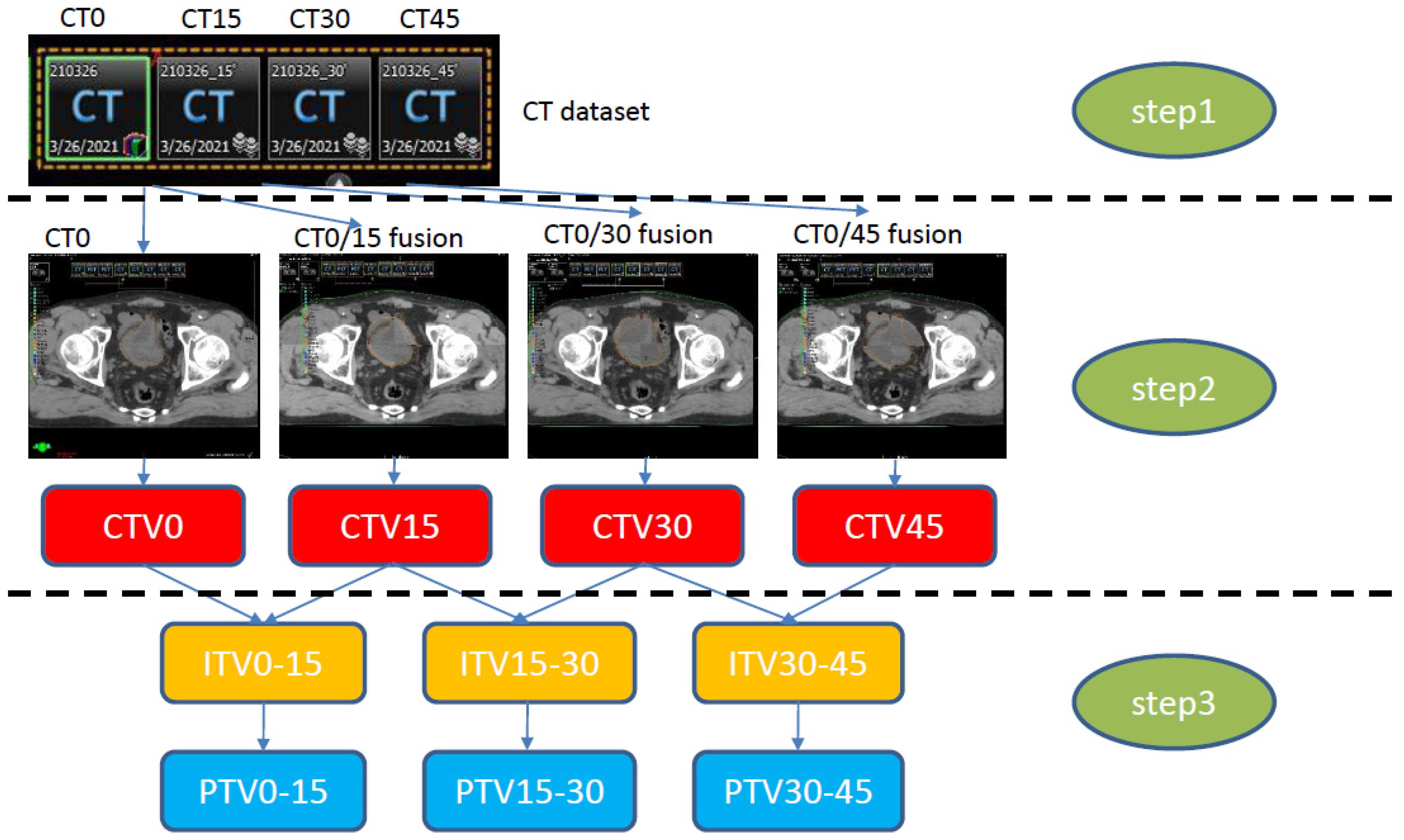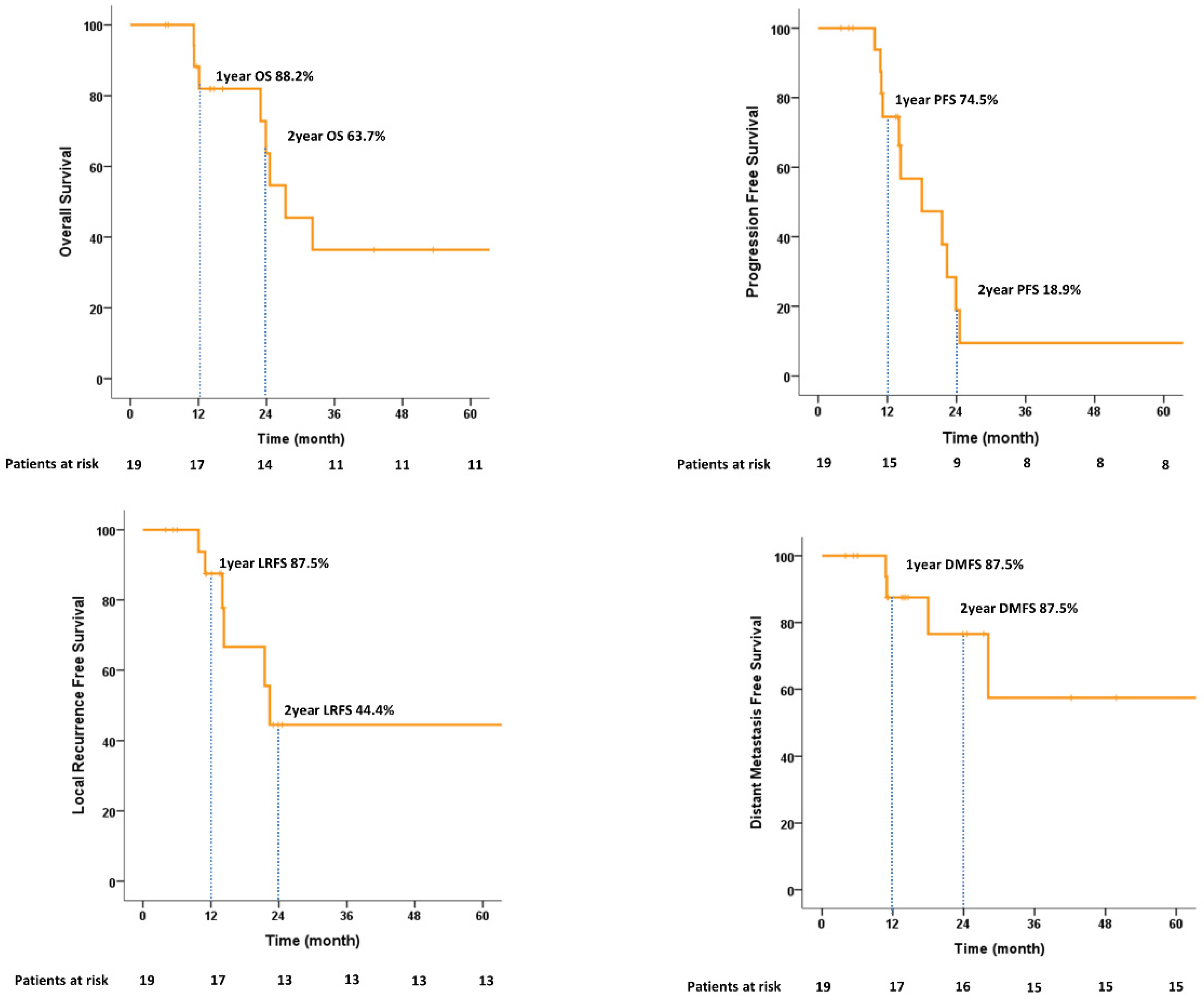Optimized Adaptive Radiotherapy with Individualized Plan Library for Muscle-Invasive Bladder Cancer Using Internal Target Volume Generation
Abstract
:Simple Summary
Abstract
1. Introduction
2. Materials and Methods
2.1. Patient Selection
2.2. General RT Schedule
2.3. Plan Library Generation
2.4. Treatment Planning
2.5. Online Adaptive Radiotherapy Workflow
2.6. Validation Workflow
2.7. Survival and Toxicity Assessment
2.8. Statistical Analysis
2.9. Ethical Statement
3. Result
3.1. Patient Characteristics
3.2. Plan Selection
3.3. Comparing ART PTV with Conventional Pseudo-PTV
3.4. Post-Treatment CBCT Bladder Coverage
3.5. Treatment Outcomes
3.6. Treatment-Related RT Toxicity
4. Discussion
5. Conclusions
Supplementary Materials
Author Contributions
Funding
Institutional Review Board Statement
Informed Consent Statement
Data Availability Statement
Conflicts of Interest
References
- Sung, H.; Ferlay, J.; Siegel, R.L.; Laversanne, M.; Soerjomataram, I.; Jemal, A.; Bray, F. Global cancer statistics 2020: GLOBOCAN estimates of incidence and mortality worldwide for 36 cancers in 185 countries. CA A Cancer J. Clin. 2021, 71, 209–249. [Google Scholar] [CrossRef] [PubMed]
- James, N.D.; Hussain, S.A.; Hall, E.; Jenkins, P.; Tremlett, J.; Rawlings, C.; Crundwell, M.; Sizer, B.; Sreenivasan, T.; Hendron, C.; et al. Radiotherapy with or without chemotherapy in muscle-invasive bladder cancer. N. Engl. J. Med. 2012, 366, 1477–1488. [Google Scholar] [CrossRef] [PubMed]
- Efstathiou, J.A.; Spiegel, D.Y.; Shipley, W.U.; Heney, N.M.; Kaufman, D.S.; Niemierko, A.; Coen, J.J.; Skowronski, R.Y.; Paly, J.J.; McGovern, F.J.; et al. Long-term outcomes of selective bladder preservation by combined-modality therapy for invasive bladder cancer: The MGH experience. Eur. Urol. 2012, 61, 705–711. [Google Scholar] [CrossRef] [PubMed]
- Efstathiou, J.A.; Mouw, K.W.; Gibb, E.A.; Liu, Y.; Wu, C.-L.; Drumm, M.R.; da Costa, J.B.; du Plessis, M.; Wang, N.Q.; Davicioni, E.; et al. Impact of immune and stromal infiltration on outcomes following bladder-sparing trimodality therapy for muscle-invasive bladder cancer. Eur. Urol. 2019, 76, 59–68. [Google Scholar] [CrossRef] [PubMed]
- Pham, A.; Ballas, L.K. Trimodality therapy for bladder cancer: Modern management and future directions. Curr. Opin. Urol. 2019, 29, 210. [Google Scholar] [CrossRef] [PubMed]
- Royce, T.J.; Feldman, A.S.; Mossanen, M.; Yang, J.C.; Shipley, W.U.; Pandharipande, P.V.; Efstathiou, J.A. Comparative effectiveness of bladder-preserving tri-modality therapy versus radical cystectomy for muscle-invasive bladder cancer. Clin. Genitourin. Cancer 2019, 17, 23–31.e3. [Google Scholar] [CrossRef] [PubMed]
- Portner, R.; Bajaj, A.; Elumalai, T.; Huddart, R.; Murthy, V.; Nightingale, H.; Patel, K.; Sargos, P.; Song, Y.; Hoskin, P.; et al. A practical approach to bladder preservation with hypofractionated radiotherapy for localised muscle-invasive bladder cancer. Clin. Transl. Radiat. Oncol. 2021, 31, 1–7. [Google Scholar] [CrossRef]
- Kavanagh, B.D.; Pan, C.C.; Dawson, L.A.; Das, S.K.; Li, X.A.; Ten Haken, R.K.; Miften, M. Radiation dose–volume effects in the stomach and small bowel. Int. J. Radiat. Oncol. Biol. Phys. 2010, 76, S101–S107. [Google Scholar] [CrossRef]
- Ugurluer, G.; Mustafayev, T.Z.; Gungor, G.; Atalar, B.; Abacioglu, U.; Sengoz, M.; Agaoglu, F.; Demir, G.; Ozyar, E. Stereotactic MR-guided online adaptive radiation therapy (SMART) for the treatment of liver metastases in oligometastatic patients: Initial clinical experience. Radiat. Oncol. J. 2021, 39, 33. [Google Scholar] [CrossRef]
- Şenkesen, Ö.; Tezcanlı, E.; Abacıoğlu, M.U.; Özen, Z.; Çöne, D.; Küçücük, H.; Göksel, E.O.; Arifoğlu, A.; Şengöz, M. Limited field adaptive radiotherapy for glioblastoma: Changes in target volume and organ at risk doses. Radiat. Oncol. J. 2022, 40, 9. [Google Scholar] [CrossRef]
- Glide-Hurst, C.K.; Lee, P.; Yock, A.D.; Olsen, J.R.; Cao, M.; Siddiqui, F.; Parker, W.; Doemer, A.; Rong, Y.; Kishan, A.U.; et al. Adaptive radiation therapy (ART) strategies and technical considerations: A state of the ART review from NRG oncology. Int. J. Radiat. Oncol. Biol. Phys. 2021, 109, 1054–1075. [Google Scholar] [CrossRef]
- Belshaw, L.; Agnew, C.E.; Irvine, D.M.; Rooney, K.P.; McGarry, C.K. Adaptive radiotherapy for head and neck cancer reduces the requirement for rescans during treatment due to spinal cord dose. Radiat. Oncol. 2019, 14, 189. [Google Scholar] [CrossRef]
- Piperdi, H.; Portal, D.; Neibart, S.S.; Yue, N.J.; Jabbour, S.K.; Reyhan, M. Adaptive Radiation Therapy in the Treatment of Lung Cancer: An Overview of the Current State of the Field. Front. Oncol. 2021, 11, 770382. [Google Scholar] [CrossRef] [PubMed]
- Kibrom, A.Z.; Knight, K.A. Adaptive radiation therapy for bladder cancer: A review of adaptive techniques used in clinical practice. J. Med. Radiat. Sci. 2015, 62, 277–285. [Google Scholar] [CrossRef] [PubMed]
- Lalondrelle, S.; Huddart, R.; Warren-Oseni, K.; Hansen, V.N.; McNair, H.; Thomas, K.; Dearnaley, D.; Horwich, A.; Khoo, V. Adaptive-predictive organ localization using cone-beam computed tomography for improved accuracy in external beam radiotherapy for bladder cancer. Int. J. Radiat. Oncol. Biol. Phys. 2011, 79, 705–712. [Google Scholar] [CrossRef]
- Grønborg, C.; Vestergaard, A.; Høyer, M.; Söhn, M.; Pedersen, E.M.; Petersen, J.B.; Agerbæk, M.; Muren, L.P. Intra-fractional bladder motion and margins in adaptive radiotherapy for urinary bladder cancer. Acta Oncol. 2015, 54, 1461–1466. [Google Scholar] [CrossRef]
- Zapatero, A.; De Vidales, C.M.; Arellano, R.; Ibañez, Y.; Bocardo, G.; Perez, M.; Rabadan, M.; Vicente, F.G.; Conde, J.A.C.; Olivier, C. Long-term results of two prospective bladder-sparing trimodality approaches for invasive bladder cancer: Neoadjuvant chemotherapy and concurrent radio-chemotherapy. Urology 2012, 80, 1056–1062. [Google Scholar] [CrossRef]
- Yeh, J.; Bressel, M.; Tai, K.H.; Kron, T.; Foroudi, F. A retrospective review of the long-term outcomes of online adaptive radiation therapy and conventional radiation therapy for muscle invasive bladder cancer. Clin. Transl. Radiat. Oncol. 2021, 30, 65–70. [Google Scholar] [CrossRef]
- Arcangeli, G.; Strigari, L.; Arcangeli, S. Radical cystectomy versus organ-sparing trimodality treatment in muscle-invasive bladder cancer: A systematic review of clinical trials. Crit. Rev. Oncol. Hematol. 2015, 95, 387–396. [Google Scholar] [CrossRef]
- Yan, D.; Vicini, F.; Wong, J.; Martinez, A. Adaptive radiation therapy. Phys. Med. Biol. 1997, 42, 123. [Google Scholar] [CrossRef]
- Burridge, N.; Amer, A.; Marchant, T.; Sykes, J.; Stratford, J.; Henry, A.; McBain, C.; Price, P.; Moore, C. Online adaptive radiotherapy of the bladder: Small bowel irradiated-volume reduction. Int. J. Radiat. Oncol. Biol. Phys. 2006, 66, 892–897. [Google Scholar] [CrossRef] [PubMed]
- Vestergaard, A.; Muren, L.; Lindberg, H.; Jakobsen, K.L.; Petersen, J.B.B.; Elstrøm, U.V.; Agerbaek, M.; Høyer, M. Normal tissue sparing in a phase II trial on daily adaptive plan selection in radiotherapy for urinary bladder cancer. Acta Oncol. 2014, 53, 997–1004. [Google Scholar] [CrossRef] [PubMed]
- Foroudi, F.; Wong, J.; Kron, T.; Rolfo, A.; Haworth, A.; Roxby, P.; Thomas, J.; Herschtal, A.; Pham, D.; Williams, S.; et al. Online adaptive radiotherapy for muscle-invasive bladder cancer: Results of a pilot study. Int. J. Radiat. Oncol. Biol. Phys. 2011, 81, 765–771. [Google Scholar] [CrossRef] [PubMed]
- McDonald, F.; Lalondrelle, S.; Taylor, H.; Warren-Oseni, K.; Khoo, V.; McNair, H.; Harris, V.; Hafeez, S.; Hansen, V.; Thomas, K.; et al. Clinical implementation of adaptive hypofractionated bladder radiotherapy for improvement in normal tissue irradiation. Clin. Oncol. 2013, 25, 549–556. [Google Scholar] [CrossRef] [PubMed]
- Turner, S.L.; Swindell, R.; Bowl, N.; Marrs, J.; Brookes, B.; Read, G.; Cowan, R.A. Bladder movement during radiation therapy for bladder cancer: Implications for treatment planning. Int. J. Radiat. Oncol. Biol. Phys. 1997, 39, 355–360. [Google Scholar] [CrossRef]
- Murthy, V.; Master, Z.; Adurkar, P.; Mallick, I.; Mahantshetty, U.; Bakshi, G.; Tongaonkar, H.; Shrivastava, S. ‘Plan of the day’adaptive radiotherapy for bladder cancer using helical tomotherapy. Radiother. Oncol. 2011, 99, 55–60. [Google Scholar] [CrossRef]
- Tuomikoski, L.; Collan, J.; Keyriläinen, J.; Visapää, H.; Saarilahti, K.; Tenhunen, M. Adaptive radiotherapy in muscle invasive urinary bladder cancer–an effective method to reduce the irradiated bowel volume. Radiother. Oncol. 2011, 99, 61–66. [Google Scholar] [CrossRef]
- McPartlin, A.; Li, X.; Kershaw, L.; Heide, U.; Kerkmeijer, L.; Lawton, C.; Mahmood, U.; Pos, F.; van As, N.; van Herk, M.; et al. MRI-guided prostate adaptive radiotherapy–A systematic review. Radiother. Oncol. 2016, 119, 371–380. [Google Scholar] [CrossRef]
- Oh, S.; Stewart, J.; Moseley, J.; Kelly, V.; Lim, K.; Xie, J.; Fyles, A.; Brock, K.K.; Lundin, A.; Rehbinder, H.; et al. Hybrid adaptive radiotherapy with on-line MRI in cervix cancer IMRT. Radiother. Oncol. 2014, 110, 323–328. [Google Scholar] [CrossRef]
- Vestergaard, A.; Hafeez, S.; Muren, L.; Nill, S.; Høyer, M.; Hansen, V.N.; Grønborg, C.; Pedersen, E.M.; Petersen, J.B.; Huddart, R.; et al. The potential of MRI-guided online adaptive re-optimisation in radiotherapy of urinary bladder cancer. Radiother. Oncol. 2016, 118, 154–159. [Google Scholar] [CrossRef]




| Characteristics | n = 19 | |
|---|---|---|
| Age, years (median, (range)) | 80 | (66–91) |
| Sex (n (%)) | ||
| Male | 13 | 68.4 |
| Female | 6 | 31.6 |
| Charlson Comorbidity Index (median, (range)) | 3 | (2–6) |
| ECOG status (n (%)) | ||
| 0–1 | 18 | 94.7 |
| 2–3 | 1 | 5.3 |
| T stage (n (%)) | ||
| T1 | 0 | 0 |
| T2 | 13 | 68.4 |
| T3 | 5 | 26.3 |
| T4 | 1 | 5.3 |
| AJCC 8th Stage (n (%)) | ||
| I | 0 | 0 |
| II | 13 | 68.4 |
| III | 6 | 31.6 |
| IV | 0 | 0 |
| Induction CTx (n (%)) | ||
| Received | 6 | 31.6 |
| Not received | 13 | 68.4 |
| CCRT (n (%)) | ||
| Received | 10 | 52.6 |
| Not received | 9 | 47.4 |
| RT dose, Gy (median, (range)) | 64.0 | (62.0–66.0) |
| RT technique (n (%)) | ||
| VMAT | 19 | 100 |
| PTV volume, cm³ (mean, ±standard deviation) | ||
| PTV0–15 | 222.3 | 73.6 |
| PTV15–30 | 260.4 | 82.1 |
| PTV30–45 | 306.8 | 98.5 |
| CTV+1 cm | 304.8 | 101.6 |
| CTV+1.5 cm | 446.7 | 144.7 |
| F/U duration, month (median, (range)) | 14.2 | (4.0–76.0) |
| Toxicity | n = 19 |
|---|---|
| Early GI toxicity | |
| Grade 1 | 6 |
| Grade 2 | 0 |
| Grade 3 | 0 |
| Early GU toxicity | |
| Grade 1 | 18 |
| Grade 2 | 1 |
| Grade 3 | 0 |
| Late GI toxicity | |
| Grade 1 | 3 |
| Grade 2 | 0 |
| Grade 3 | 0 |
| Late GU toxicity | |
| Grade 1 | 12 |
| Grade 2 | 1 |
| Grade 3 | 0 |
| Toxicity | n = 19 |
Publisher’s Note: MDPI stays neutral with regard to jurisdictional claims in published maps and institutional affiliations. |
© 2022 by the authors. Licensee MDPI, Basel, Switzerland. This article is an open access article distributed under the terms and conditions of the Creative Commons Attribution (CC BY) license (https://creativecommons.org/licenses/by/4.0/).
Share and Cite
Jo, Y.Y.; Yea, J.W.; Park, J.; Oh, S.A.; Park, J.W. Optimized Adaptive Radiotherapy with Individualized Plan Library for Muscle-Invasive Bladder Cancer Using Internal Target Volume Generation. Cancers 2022, 14, 4674. https://doi.org/10.3390/cancers14194674
Jo YY, Yea JW, Park J, Oh SA, Park JW. Optimized Adaptive Radiotherapy with Individualized Plan Library for Muscle-Invasive Bladder Cancer Using Internal Target Volume Generation. Cancers. 2022; 14(19):4674. https://doi.org/10.3390/cancers14194674
Chicago/Turabian StyleJo, Yoon Young, Ji Woon Yea, Jaehyeon Park, Se An Oh, and Jae Won Park. 2022. "Optimized Adaptive Radiotherapy with Individualized Plan Library for Muscle-Invasive Bladder Cancer Using Internal Target Volume Generation" Cancers 14, no. 19: 4674. https://doi.org/10.3390/cancers14194674






